Technology
The best 60 percent keyboards of 2024
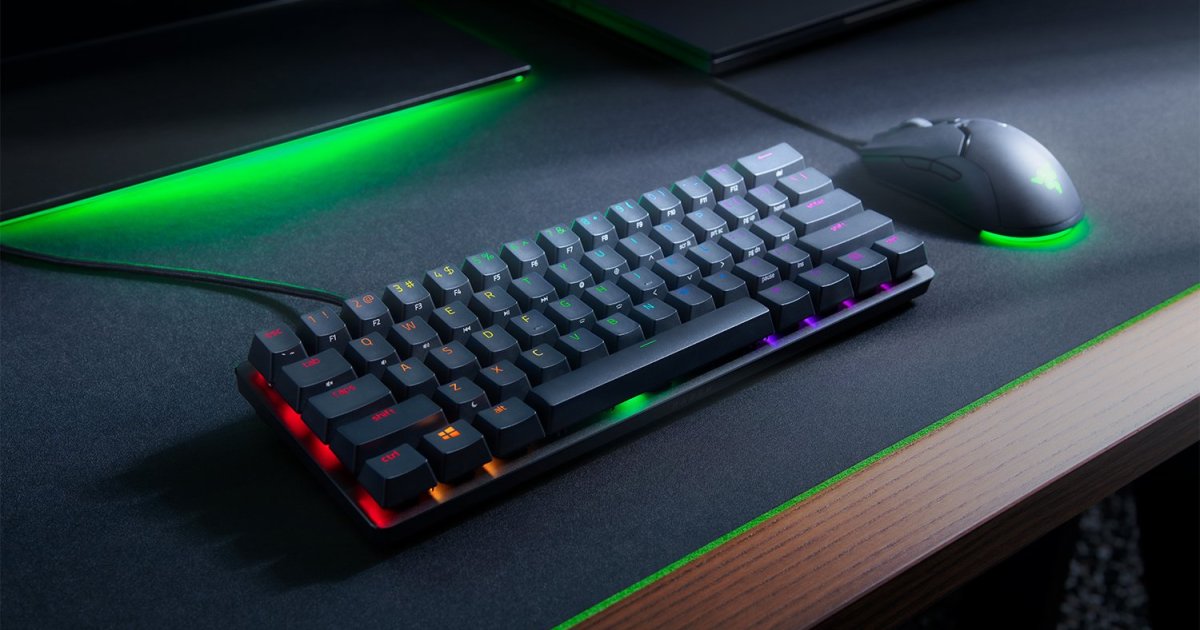

Razer / Razer
Modern keyboards are manufactured to such a high standard that even the compact 60% versions can cram in most of the same features as the very best keyboards of any size. The distinct look, compact sizing, and often better pricing of 60% keyboards make this a keyboard type well worth considering. That’s especially true if you’re already looking at the best mechanical keyboards — many of them are one and the same.
With a number of keyboard makers offering the compact form factor for gamers and typists, it shouldn’t be tough to find the right one for you. Here are some of the best 60 percent keyboards that we recommend.
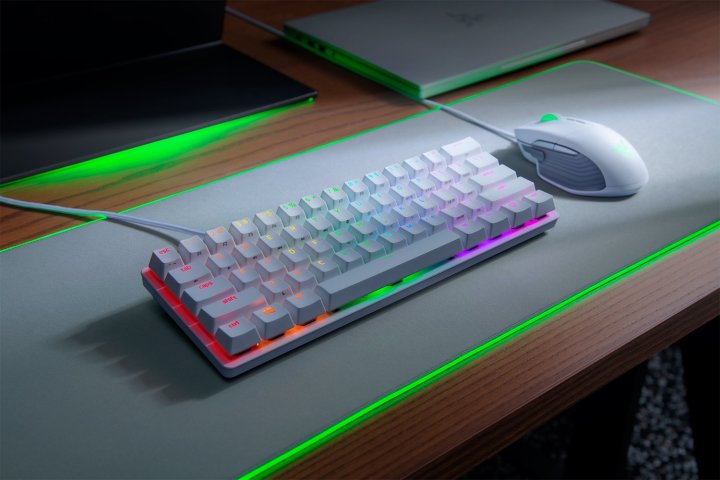
Image used with permission by copyright holder
Razer Huntsman Mini Analog
Best 60 percent keyboard
Pros
- Software customization with onboard memory
- Individually lit RGB keys
- Customizable actuation distance
- Detachable USB cable
Why should you buy this: It’s a premium gaming keyboard with fast optical analog switches.
Who’s it for: Gamers and occasional typists in need of a feature-rich compact keyboard.
Why we picked the Razer Huntsman Mini:
Razer is a reliable name in the peripherals space, and its 60 percent keyboard offering, the Huntsman Mini Analog, is a feature-packed compact keyboard solution with some of the most advanced switches you can find. It is available in black or white (Mercury) color schemes with a total of 61 keys and a detachable USB-C cable. Despite the premium price, the build is all plastic, which was probably done to keep the overall weight to a minimum. The company includes its own doubleshot PBT keycaps with a superthin font that allows for sharp-looking letters.
The real standout feature with this keyboard, though, are the analog switches. They combine the performance of optical switches with near-infinite customization, letting you fine-tune the actuation distance for the task at hand. Shallow and responsive for gaming, deeper for greater typing accuracy, or any combination for any key(s) you wish — it’s all adjustable within the backend software, alongside the excellent Razer Chroma RGB per-key backlighting.
Whether you’re looking to type fast, game slow, vice versa, or anything in between, the Huntsman Mini Analog is the best 60% keyboard for the job.

Razer Huntsman Mini Analog
Best 60 percent keyboard
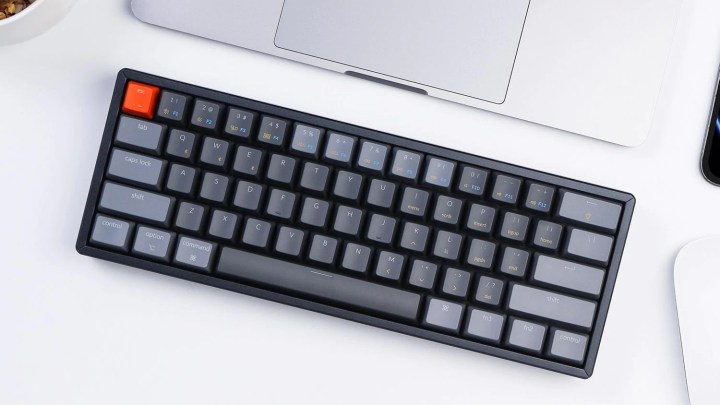
Image used with permission by copyright holder
Keychron K12
Best compact keyboard for multi-device setup
Pros
- Solid build quality
- Wired and wireless operation
- Multi-device pairing
- Optional hot-swap switches
Cons
- Not the best with latency
- Could use a wrist rest
Why should you buy this: Highly compatible and well-rounded wireless keyboard.
Who’s it for: Working professionals with a multi-device setup.
Why we picked the Keychron K12:
Keychron started off as a Kickstarter project in 2018 and today offers a range of keyboards available in various layouts. The K12 is the company’s 60 percent offering that offers both wired and wireless connectivity. It is compatible with both MacOS and Windows, with additional keycaps so you can get the right layout. It can also be used with Linux, Android, and iOS devices. With Bluetooth 5.1, the keyboard can pair and quickly switch between three devices, making it perfect for someone who has to deal with more than one device. Available with factory-fitted Gateron G Pro mechanical switches (red, blue, or brown), one can also buy the K12 in a hot-swap version where you can choose between Gateron G Pro and Keychron’s own optical switches. Additionally, you get the option of white or RGB backlighting for the keys, as well as an aluminum frame for that extra sturdiness.
The inbuilt 4,000mAh battery can last about two months (with backlighting turned off) before it needs a recharge. There is no dedicated software, which means there are no options to program macros, but there are dedicated keys to control the RGB lighting. Also, the keyboard is a little thick and could use a third-party wrist rest for added comfort.
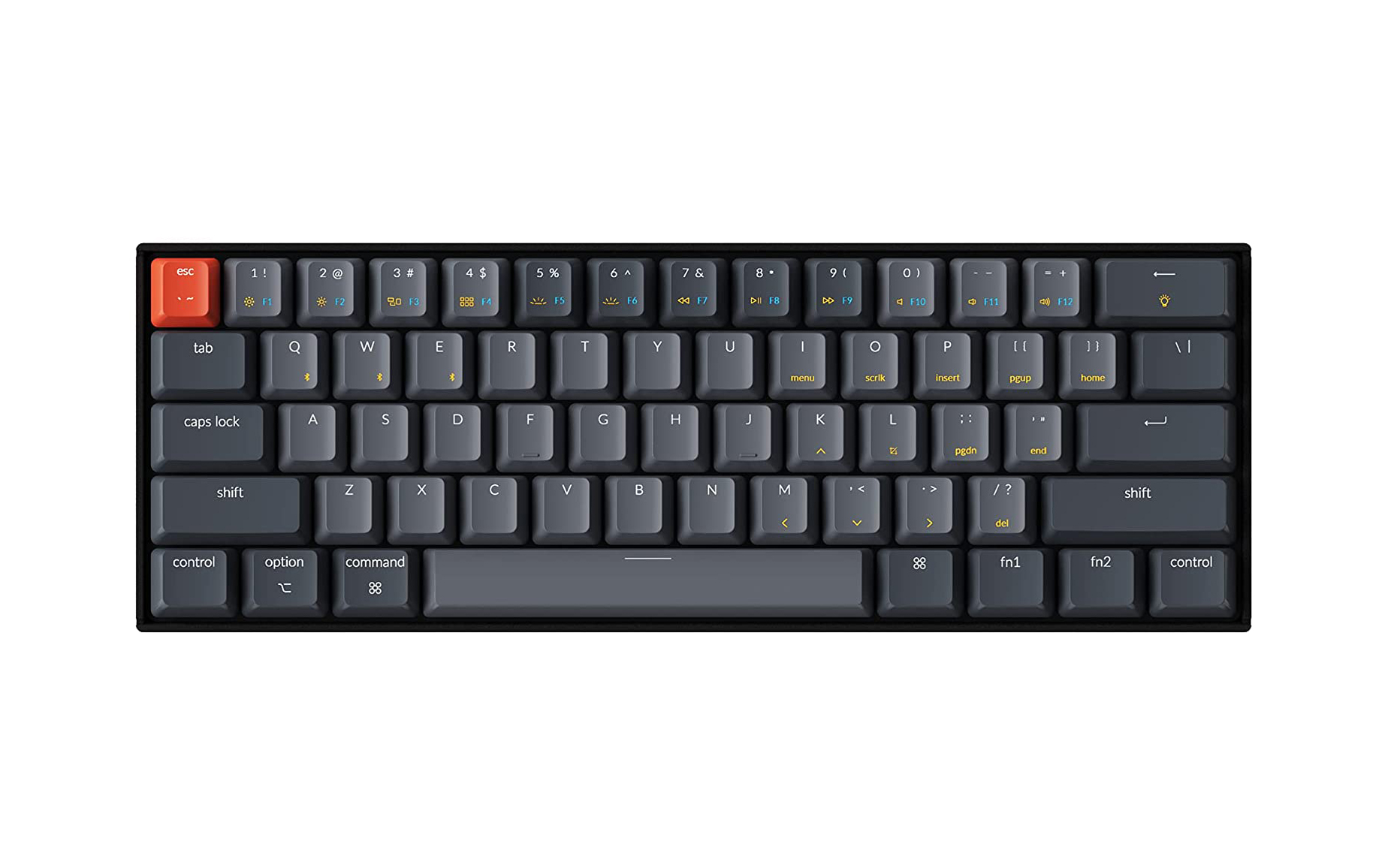
Keychron K12
Best compact keyboard for multi-device setup

Jacob Roach / Digital Trends
SteelSeries Apex Pro Mini
Best 60% keyboard for gaming
Pros
- Unique Omnipoint 2.0 switches
- Dual actuation inputs
- Perfect size for gamers
- Satisfying typing and gaming experience
- Bluetooth and 2.4GHz connections
Cons
- Unnecessarily expensive
- SteelSeries GG is a bit confusing
- 60% form factor limits use cases
Why should you buy this: It’s fantastic for gaming purists.
Who’s it for: Gamers who don’t want any wasted space or keys.
Why we picked the SteelSeries Apex Pro Mini:
The SteelSeries Apex Pro Mini is a lean and mean gaming keyboard, with all of the keys you need built on SteelSeries’ fantastically responsive and customizable Omnipoint 2.0 switches. They have dual actuation, so you can use granular controls in racers and games with nuanced inputs. They also unlock additional potential for more controls within the confines of a more compact design.
The keyboard is entirely wireless, and can run off Bluetooth or the 2.4 GHz wireless dongle. It’s rated for 40 hours of battery life with the lights on, but if you run it on low or don’t run it continuously, you should get far longer than that on a single charge.
The adjustable switches can be incredibly fast if you lower the actuation distance to fractions of a millimeter, and you can always extend that again for more accurate typing. RGB lighting is excellent, too, with per-key controls adjustable in the SteelSeries software.

SteelSeries Apex Pro Mini
Best 60% keyboard for gaming
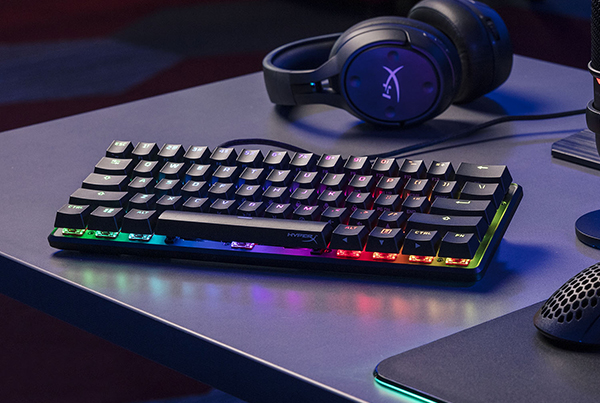
Image used with permission by copyright holder
HyperX Alloy Origins 60
Rock solid gaming keyboard
Pros
- Robust build quality
- Competitive pricing
- Responsive and silent key switches
- Great RGB LED lighting
Cons
- Low onboard memory
- Custom software limited to Windows users
Why should you buy this: Great value for the asking price.
Who’s it for: Budget-focused gamers looking for a reliable compact keyboard.
Why we picked the HyperX Alloy Origins 60:
The HyperX Alloy Origins 60 is a highly praised 60 percent keyboard for gamers featuring one of the most compact designs, paired with a rock-solid build and an excellent price tag. It makes use of high-quality plastics, an aircraft-grade aluminum top frame, and a detachable USB-C cable that is braided for longevity. The company offers the keyboard with its own linear red mechanical switches and Doubleshot PBT keycaps with 45G actuation force and 1.8mm actuation distance. There is per-key RGB lighting as well and adjustable feet that offer three different angles of inclination. One can easily set macros and control the RGB lighting using the NGenuity software, while the keyboard’s onboard memory can save up to three profiles. The software also lets you customize functions and assign them to almost any key on the Base Layer or the Fn Layer.
Overall, the Alloy Origins 60 performs quite well, with light and silent operation and extremely low click latency. It’s also very affordable compared to its competitors, especially since HyperX bundles a keycap remover with some extra keycaps, including a trippy-looking spacebar keycap.

HyperX Alloy Origins 60
Rock solid gaming keyboard

Image used with permission by copyright holder
Happy Hacking Keyboard Professional 2
One of a kind 60 percent keyboard with capacitive switches
Pros
- Clean retro design
- Long-lasting build quality
- Wired and wireless connectivity
- Topre switches
Cons
- Unusual layout
- No backlighting
- High price
Why should you buy this: Minimalist design with premium Topre key switches.
Who’s it for: Programmers and typists looking for a unique experience.
Why we picked the Happy Hacking Keyboard Professional 2:
Focusing on aesthetics and a great typing experience, the Happy Hacking Keyboard Professional 2 or the HHKB Pro 2 is one of the most unique products on this list. Catering to a niche audience, it features an understated retro design, solid PBT keycaps, and Japanese Topre key switches, all of which manage to deliver an interesting typing experience. There is a steep learning curve though, as the keyboard doesn’t have a traditional layout, especially when it comes to the Control key that is positioned where the Caps Lock key should be. The capacitive non-contact Topre switches are definitely the highlight of the keyboard, offering linear and smooth key travel, almost like a superior version of the Cherry MX Brown switches.
As for connectivity, there are two pass-through USB ports to attach additional peripherals or thumb drives, and for some odd reason, a mini-USB port for connecting your PC. You also get Bluetooth connectivity that allows you to wirelessly connect multiple devices. Apart from the confusing layout, the biggest issue with this keyboard is the price. Currently available for over $300, the HHKB Pro 2 is one of the most expensive 60 percent keyboards on the market.

Happy Hacking Keyboard Professional 2
One of a kind 60 percent keyboard with capacitive switches

Image used with permission by copyright holder
Corsair K65 RGB Mini
Appealing design with strong software ecosystem.
Pros
- Customization options
- Bright RGB lighting
- Up to 50 custom profiles
- Great design
Cons
- Misses out on adjustable feet
- 8,000Hz polling rate doesn’t make a difference
Why should you buy this: Great design aesthetics with multiple customization options.
Who’s it for: Gamers who seek a good-looking design and robust software ecosystem.
Why we picked the Corsair K65 RGB Mini:
Corsair made its entry into the 60 percent keyboard category K65 RGB Mini and did so with gusto. The advertised “hero feature” of the keyboard is its class-leading 8,000Hz polling rate, though that shouldn’t be the only reason for you to buy one. It comes with a pleasing design and bright RGB lighting, making it one of the most premium-looking 60 percent keyboards. You also get a removable USB-C cable, Doubleshot PBT keycaps, and the option of Cherry MX Red, brown, blue, Silent, and Speed key switches. Available in black or white color schemes, Corsair additionally sells custom-colored keycap sets for the K65 RGB Mini to please enthusiasts. Then there is the iCUE software integration, which has become one of the best in the business, giving you full control of the RGB lighting as well as a variety of other options to play with.
This is definitely one of the most practical 60 percent keyboards with minor gripes. It misses out on adjustable feet, meaning you cannot change the angle of inclination, and for a $100 keyboard, one expects a metal top frame for that extra rigidity.

Corsair K65 RGB Mini
Appealing design with strong software ecosystem.
Frequently Asked Questions
What is a 60 percent keyboard?
While a traditional keyboard comes with 104 keys, a 60 percent keyboard has a total of 60 to 62 keys. It sacrifices most of the function keys, including the number pad, arrow keys, and other miscellaneous keys, in favor of a compact and sleek design. Such keyboards offer great portability and take up very little desk space, which is great for compact or minimalistic setups.
Are 60 percent keyboards good for gaming?
Certain gamers today prefer using a 60 percent keyboard as they are easy to maneuver and position at different angles, while the compact size makes more room for mouse movements. Additionally, most 60 percent keyboards offer the ability to set macros and choose between various key switches, which is again quite useful while gaming.
How expensive are 60 percent keyboards?
Due to their smaller size, 60 percent keyboards are relatively cheaper compared to full-size keyboards. Having said that, you can find a compact keyboard for as low as $50 going all the way up to $100. There are also some exceptions, like the Happy Hacking Keyboard Professional 2, which costs upwards of $300!
What are the drawbacks of 60 percent keyboards?
There are a number of keys that are not immediately available on 60 percent of keyboards, which may hamper your overall productivity. You can access the missing keys by rebinding the keys you do have, but there is a learning curve with that, and it definitely takes time to get used to the layout. If you are someone who heavily uses the numpad or the function keys, you will be better off with one of the best full-size keyboards.
Technology
SingleStore’s BryteFlow acquisition targets data integration

SingleStore on Thursday completed the acquisition of data integration specialist Bryte Systems, commonly referred to as BryteFlow, in a move aimed at expanding SingleStore’s ability to ingest and integrate data from a broad array of sources.
Financial terms of the deal were not disclosed.
Once SingleStore combines BryteFlow’s technology with its own, it plans to launch a new data integration environment branded SingleConnect, according to SingleStore.
Based in San Francisco, SingleStore is a former database specialist that has expanded to provide full data platform capabilities that compete with vendors such as Databricks and Snowflake. Its tools, which include data integration capabilities, are designed to quickly ingest data from various sources to inform decisions in near real time.
BryteFlow, meanwhile, is a data integration vendor based in Sydney, Australia, whose no-code BrtyteFlow platform ingests data from applications such as SAP and Salesforce as well as databases to fuel real-time decision-making. Key to its effectiveness are its change data capture (CDC) capabilities, which help fuel real-time analysis.
Given that SingleStore and BryteFlow both specialize in enabling real-time decisions and that BryteFlow’s CDC capabilities add to SingleStore’s existing offering, the acquisition is appropriate, according to Matt Aslett, an analyst at IDG’s Ventana Research.
SingleStore is not alone among data platform vendors acquiring data ingestion and integration specialists, he noted. For example, Databricks bought Arcion in 2023. But SingleStore’s acquisition of BryteFlow is particularly significant because of the real-time processing capabilities BryteFlow provides.
“There is an ongoing trend of data platform providers incorporating data integration functionality with their data persistence and processing capabilities to accelerate actionable insight,” Aslett said. “This is especially relevant for SingleStore given that it is often used to support applications that require real-time analysis.”
The acquisition comes less than two weeks after SingleStore unveiled a strategic partnership with Snowflake to help joint customers develop real-time AI applications and about four months after launching an integration with open source table storage platform Apache Iceberg.
Data ingestion and integration have always been part of SingleStore’s platform.
Founded in 2011 as MemSQL before changing its name in 2020, the vendor began as a database specialist that competed with the likes of MongoDB and Couchbase before adding more data management capabilities and evolving into a data platform vendor.
One constant throughout its evolution has been a focus on speed and enabling near real-time analysis. Throughout 2022, SingleStore raised financing — a total of $146 million in a two-part Series F-2 funding round — that was used, in part to fuel product development.
The following year, the vendor unveiled a series of capabilities aimed at enabling customers to develop and deploy real-time AI models and applications, including vector search and a new compute layer. This year, SingleStore continued to invest in enabling real-time analytics and AI by partnering with Snowflake and integrating with Apache Iceberg.
It was amid its funding in 2022 — 10 days after unveiling the first part its Series F-2 round — that SingleStore introduced its initial CDC capabilities.
CDC is the process of identifying and capturing changes made to data and then delivering those changes to other applications in real-time. For example, if there is a change to a dataset within a database or application such as HubSpot, for example, that change is immediately sent to whatever analytics and AI applications are informed by that dataset. The intent is to inform decisions and actions by using the most current data available.
The acquisition of BryteFlow adds to SingleStore’s existing CDC capabilities by providing prebuilt data integration tools — which include CDC — for applications such as SAP and Salesforce. In addition, BryteFlow’s platform includes prebuilt data integration tools — also including CDC — for data storage platforms from vendors including AWS, Databricks, Microsoft and Oracle that might be used in conjunction with SingleStore to inform AI and analytics tools.
As a result, BryteFlow’s platform serves as a complement to SingleStore’s existing tools and the eventual development and launch of SingleConnect will represent improvement for SingleStore, according to Aslett.
“The acquisition of BryteFlow and its CDC capabilities enhances SingleStore’s ability to support real-time analytics,” he said. “The incorporation of BryteFlow’s functionality … as SingleConnect complements and extends SingleStore’s existing investment in data integration [with] enhanced functionality to support applications that rely on real-time processing and analysis from multiple data sources.” Raj Verma, SingleStore’s CEO, noted that the vendor already enables users to ingest and analyze petabytes of data in real time. Acquiring BryteFlow is aimed at making it easier by adding full CDC capabilities connected to new data sources.
“This acquisition effectively widens the choices for our customers, offering them more ways to connect to a broad range of enterprise and SaaS applications in addition to databases across on-premises systems and all major cloud service providers.” Verma said.
The impetus for the acquisition, meanwhile, came from SingleStore’s ongoing effort to simplify data movement across various systems, he continued, noting that most enterprises use multiple databases to store information.
“Without streamlined data estates, it’s difficult for organizations to build intelligent and generative AI applications with the full breadth of their data,” Verma said. “We will continue to refine our data platform to make it easier for enterprises to store, transact, analyze and search data from any source.” While SingleStore’s acquisition of BryteFlow specifically target SingleStore’s data integration capabilities, market trends are favorable for the vendor and could help spur growth, according to Aslett.
Enterprises are continuing to place greater emphasis on real-time analysis. Meanwhile, as enterprise interest in AI — and generative AI, in particular — also increases, data management tools that can handle high-volume workloads at without losing performance speed are important.
“Industry trends are playing to the strengths of SingleStore and its ability to support data-intensive applications,” Aslett said. “Interest in hybrid data processing has risen steadily, driven by demand for real-time data processing to support the development of intelligent operational applications that deliver personalization and contextually relevant recommendations.”
With the acquisition of BryteFlow now complete, SingleStore will focus its product development roadmap on continuing to simplify data migration and management, according to Verma. In particular, the vendor aims to make it easier for enterprises to operationalize the data needed to feed and train AI and machine learning models and applications.
“We’ll make it easier for organizations to ingest data into our platform and build intelligent applications at scale,” Verma said.
Aslett, meanwhile, suggested that SingleStore needs to improve its messaging to better compete with more established data platform vendors, including tech giants such as AWS, Google Cloud and Microsoft that provide data management services.
Specifically, better messaging around SingleStore’s support for unified data management and analytics workload processing and its advantages over deploying specialized tools for each would benefit the vendor. “The company is competing with some of the biggest names in data platforms and data processing,” Aslett said. “Adoption relies on enterprises understanding suitable use cases for products able to support hybrid operational and analytic processing.”
Eric Avidon is a senior news writer for TechTarget Editorial and a journalist with more than 25 years of experience. He covers analytics and data management.
Complementary capabilities
What’s ahead
Servers computers
An Internal Tour of the Dell PowerEdge M710HD Blade Server
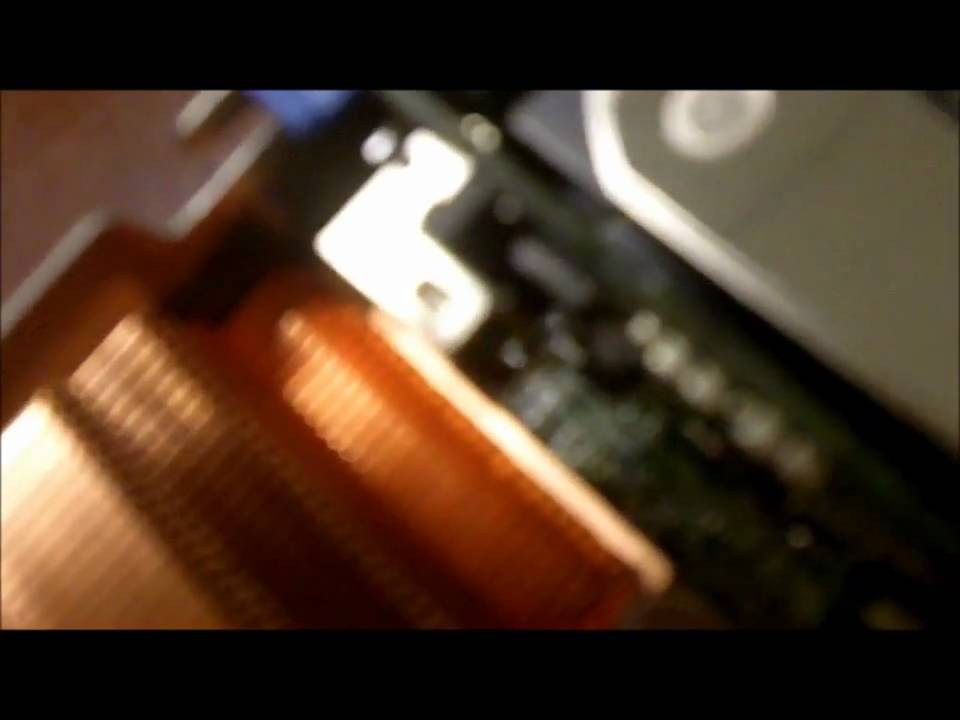
An Internal Tour of the Dell PowerEdge M710HD Blade Server .
source
Technology
OpenAI now has a $4 billion credit line on top of $6.6 billion in funding
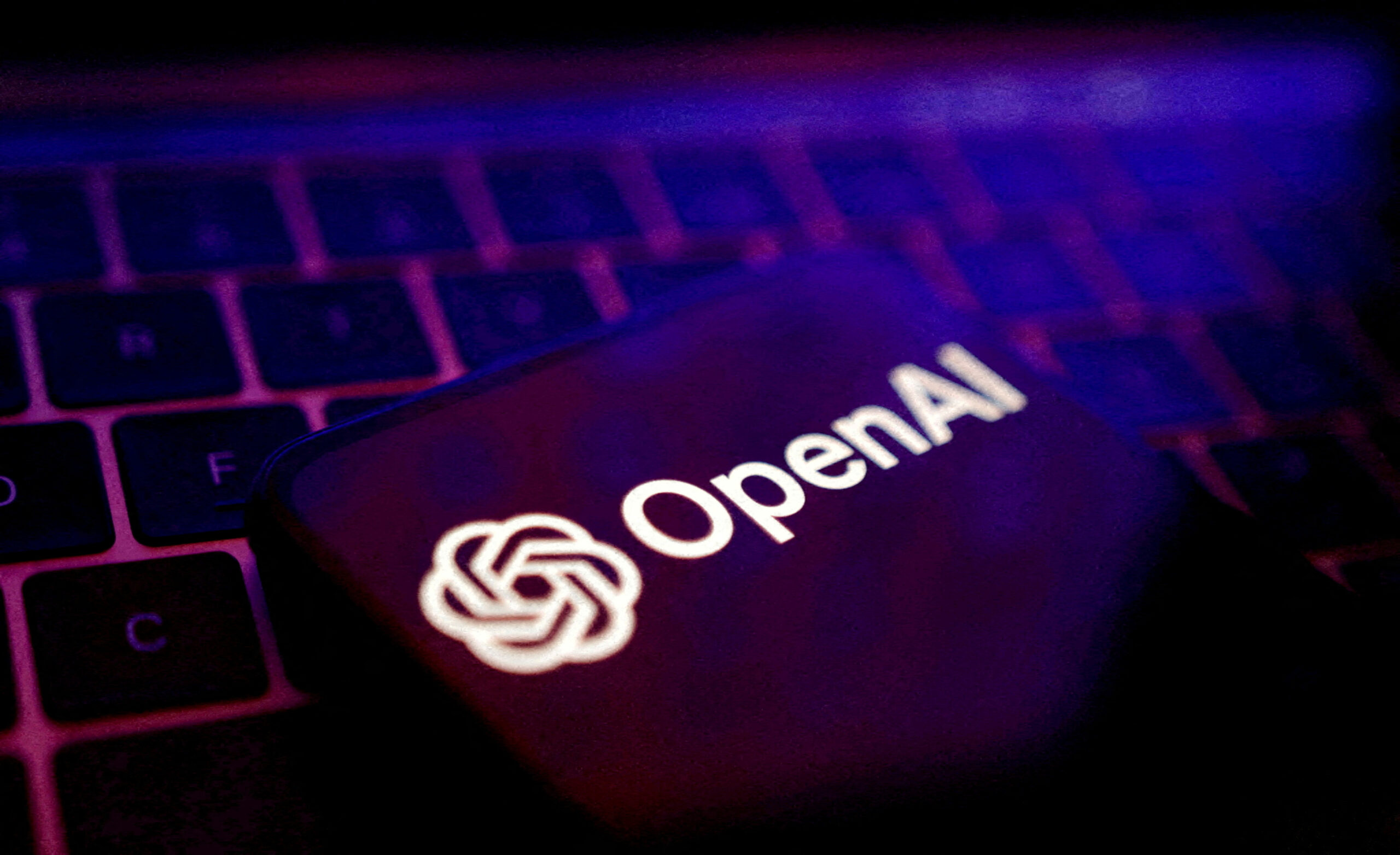
Keeping ChatGPT running is expensive as heck, so OpenAI needs access to plenty of cash to make sure the lights stay on. A day after the company said it had secured $6.6 billion in funding — the biggest ever funding round for a startup — it confirmed that it has a new $4 billion revolving line of credit. OpenAI has yet to tap the credit line, which it obtained from JPMorgan Chase, Citi, Goldman Sachs, Morgan Stanley, Santander, Wells Fargo, SMBC, UBS and HSBC. Some of those banks are also among OpenAI’s customers.
All told, OpenAI now has a war chest of over $10 billion in liquid funds. The company says that will give it the ability to invest in new projects and research, expand its infrastructure and hire top talent. “This credit facility further strengthens our balance sheet and provides flexibility to seize future growth opportunities,” OpenAI CFO Sarah Friar said.
Servers computers
Cisco UCS C240 M4 Rack Server Details
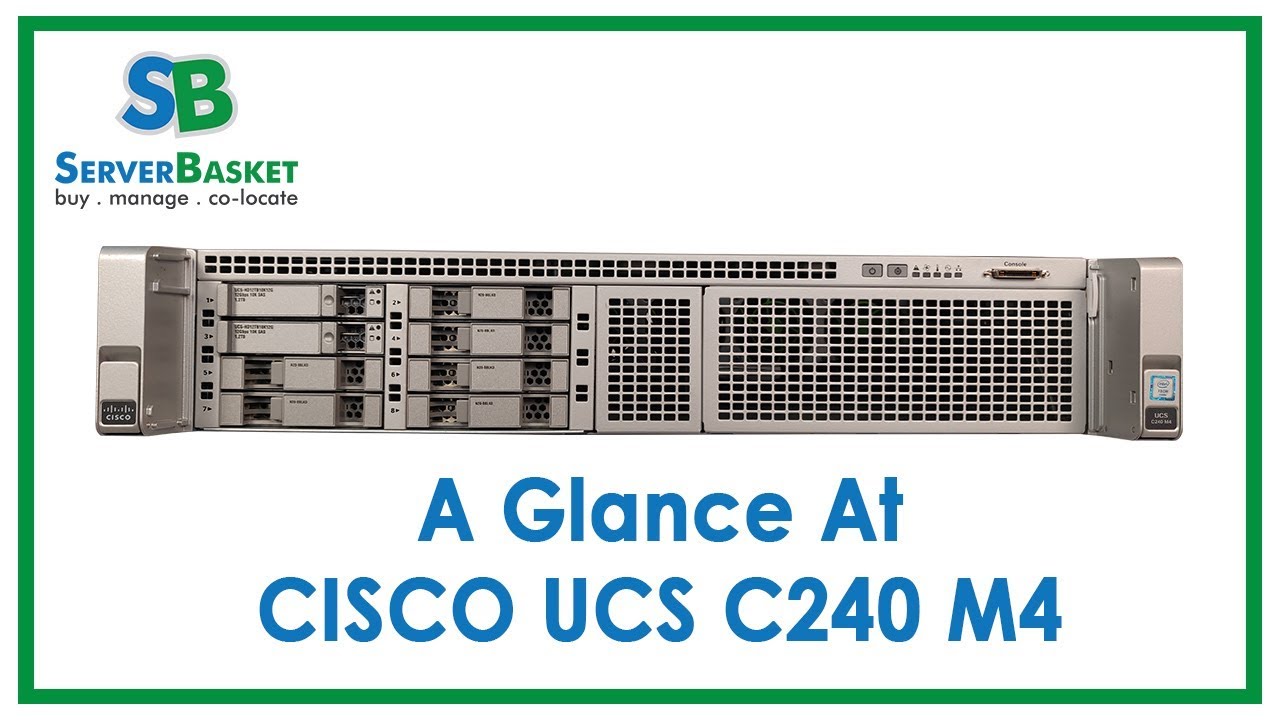
Check out the Powerful Cisco UCS C240 M4 Rack Server.
Check the Product Link:
Cisco UCS C240 M4 Rack Server Caters to All Workloads and is Compatible with Datacenter Requirements.
Key Benefits:
– Powerful Server at Lowest Price
– Economic Power Consumption
– Instant Delivery
– Easy To Use
– End-To-End Remote Management
Ciscos 240 M4 Server Specifications:
CPU Capacity:
Dual Core Server Compatible with Intel Xeon E5-2600 V3/V4 Series
Single CPU = 22 Cores Max
Dual CPUs = 44 Cores Max
RAM Capacity:
Inbuilt 24 DIMM Slots
1.5TB Maximum Memory Capacity
Supported Technology: DDR4 Memory
Storage Capacity:
8 SFF Hard Drives
Max Potential: 32TB SSD Storage
Additional Features:
6 PCIe Slots
512MB Cache 12 GBPS Raid Controller
3- 1 GBPS LAN Ports Check out the Powerful Cisco UCS C240 M4 Rack Server. .
source
Technology
Microsoft just dropped Drasi, and it could change how we handle big data
Join our daily and weekly newsletters for the latest updates and exclusive content on industry-leading AI coverage. Learn More
Microsoft has launched Drasi, a new open-source data processing system designed to simplify the detection and reaction to critical events in complex infrastructures.
This release follows last year’s launch of Radius, an open application platform for the cloud, and further cements Microsoft’s commitment to open-source innovation in cloud computing.
Mark Russinovich, CTO and Technical Fellow at Microsoft Azure described Drasi as “the birth of a new category of data processing system” in an interview with VentureBeat.
He explained that Drasi emerged from recognizing the growing complexity in event-driven architectures, particularly in scenarios like IoT edge deployments and smart building management.
From complexity to clarity
“We saw massive simplification of the architecture, just incredible developer productivity,” Russinovich said, highlighting Drasi’s potential to reduce the complexity of reactive systems.
Drasi works by continuously monitoring data sources, evaluating incoming changes through predefined queries and executing automated reactions when specific conditions are met.
This approach eliminates the need for inefficient polling mechanisms or constant data source querying, which can lead to performance bottlenecks in large-scale systems.
The system’s key innovation lies in its use of continuous database queries to monitor state changes. “What Drasi does is takes that and says, I just have a database query… and when an event comes in… Drasi knows, ‘Hey, part of this query is satisfied,’” Russinovich explained.
Open-source synergy
Microsoft’s decision to release Drasi as an open-source project aligns with its broader strategy of contributing to the open-source community, particularly in cloud-native computing.
This strategy is evident in the recent launch of Radius, which addresses challenges in deploying and managing cloud-native applications across multiple environments.
“We believe in contributing to the open-source community because… many enterprises are making strategies that are, especially around Cloud Native Computing, centered on open-source software and open governance,” Russinovich said.
The Azure Incubations team, responsible for both Drasi and Radius, has a track record of launching successful open-source projects including Dapr, KEDA and Copacetic. These projects are all available through the Cloud Native Computing Foundation (CNCF).
While Radius focuses on application deployment and management, Drasi tackles the complexities of event-driven architectures. Together, these tools represent Microsoft’s holistic approach to addressing the challenges faced by developers and operations teams in modern cloud environments.
Drasi’s continuous queries usher in a new era of reactive systems
Looking ahead, Russinovich hinted at the possible integration of Drasi into Microsoft’s data services. “It looks like it’ll probably slot into our data services, where you have Drasi integrated into Postgres database or Cosmos DB, or as a standalone service that integrates across these,” he said.
The introduction of Drasi could have significant implications for businesses grappling with the complexities of cloud-native development and event-driven architectures. By simplifying these processes, Microsoft aims to enable organizations to build more responsive and efficient applications, potentially leading to improved operational efficiency and faster time-to-market for new features.
As with Radius, Microsoft is actively seeking feedback from partners and early adopters to refine Drasi and address any scaling, performance, or security concerns that may arise in production environments. The true test for both tools will be their adoption and performance in real-world scenarios across various cloud providers and on-premises environments.
As businesses increasingly rely on cloud-native applications and real-time data processing, tools like Drasi and Radius could play a crucial role in managing the growing complexity of modern software systems.
Whether Drasi will indeed establish itself as a new category of data processing system, as Russinovich suggests, remains to be seen, but its introduction marks another significant step in Microsoft’s ongoing efforts to shape the future of cloud computing through open-source innovation.
Source link
Technology
FPV Ventures, Mill, and Bullish will be onstage at Disrupt 2024

In a world where tech trends often create a frenzy of investments, the temptation to follow the crowd can be overwhelming. But the business of trends is a dangerous game. When everyone is diving headfirst into the latest “next big thing,” the risk of falling off a cliff without genuine understanding grows exponentially.
Join us in welcoming Pegah Ebrahimi, co-founder and managing partner at FPV Ventures; Harry Tannenbaum, co-founder and president of Mill; and Natalie Sportelli, director at Bullish to TechCrunch Disrupt 2024. They’ll take to the Builders Stage to explore how founders and investors can discern true opportunities from the hype, avoiding the fate of blindly following the masses.
Disrupt 2024, taking place from October 28-30 at Moscone West in San Francisco, brings together these three dynamic leaders who understand how to precisely navigate this hype-heavy landscape. From innovative ventures in climate tech to consumer brands that buck the trend, these speakers will share their strategies for building businesses that soar.
Meet the speakers
Pegah Ebrahimi, co-founder and managing partner at FPV Ventures
Pegah Ebrahimi has extensive experience in guiding founders to success by building robust go-to-market strategies. With an impressive background as the youngest global CIO at Morgan Stanley Investment Banking and COO of Cisco’s multi-billion-dollar SaaS business, Pegah knows how to identify genuine opportunities amid the noise. As an adviser or investor in a diverse range of category-defining startups, including Snyk, Canva, and DataRobot, she helps founders rise above the lemming mentality to build sustainable, scalable businesses.
Harry Tannenbaum, co-founder and president of Mill
Harry Tannenbaum is no stranger to tackling big challenges. As co-founder and president of Mill, Harry has built an entirely new system to prevent waste, starting with food, to reimagine the role of the kitchen when it comes to sustainable living. Drawing on his experience leading analytics and scaling at Nest, Harry brings a deep understanding of how to create enduring consumer products. At Disrupt 2024, he’ll share his journey of building transformative solutions that make a lasting impact, instead of merely following trends.
Natalie Sportelli, director at Bullish
Natalie Sportelli has a keen eye for identifying the next big thing in the consumer space. Her experience at Thingtesting, Lerer Hippeau, and now Bullish — a creative agency and early-stage venture capital firm — equips her with a cultural lens to evaluate emerging businesses and pinpoint true market disruptors. Natalie’s expertise lies in balancing creativity with sound business strategies, helping early-stage consumer brands stand apart from the rush of short-lived trends and achieve long-term growth. She’ll discuss how consumer startups can stand out, stay the course, and build lasting value even when everyone else is heading toward the cliff’s edge.
Don’t miss the hype at Disrupt 2024
Join these thought leaders at Disrupt 2024 to uncover how to rise above the hype and make informed, strategic decisions for your startup. Don’t follow the crowd; learn how to lead it. Get your tickets here at a discounted rate and be part of the conversation that will redefine what it means to build and invest in lasting ventures.
-

 Womens Workouts1 week ago
Womens Workouts1 week ago3 Day Full Body Women’s Dumbbell Only Workout
-

 Science & Environment2 weeks ago
Science & Environment2 weeks agoHow to unsnarl a tangle of threads, according to physics
-

 Technology2 weeks ago
Technology2 weeks agoWould-be reality TV contestants ‘not looking real’
-

 Science & Environment2 weeks ago
Science & Environment2 weeks agoMaxwell’s demon charges quantum batteries inside of a quantum computer
-

 Science & Environment2 weeks ago
Science & Environment2 weeks agoHyperelastic gel is one of the stretchiest materials known to science
-

 Science & Environment2 weeks ago
Science & Environment2 weeks ago‘Running of the bulls’ festival crowds move like charged particles
-

 News2 weeks ago
News2 weeks agoOur millionaire neighbour blocks us from using public footpath & screams at us in street.. it’s like living in a WARZONE – WordupNews
-

 Science & Environment2 weeks ago
Science & Environment2 weeks agoHow to wrap your mind around the real multiverse
-

 Science & Environment2 weeks ago
Science & Environment2 weeks agoLiquid crystals could improve quantum communication devices
-

 Science & Environment2 weeks ago
Science & Environment2 weeks agoSunlight-trapping device can generate temperatures over 1000°C
-

 Science & Environment2 weeks ago
Science & Environment2 weeks agoITER: Is the world’s biggest fusion experiment dead after new delay to 2035?
-

 Science & Environment2 weeks ago
Science & Environment2 weeks agoPhysicists are grappling with their own reproducibility crisis
-

 Science & Environment2 weeks ago
Science & Environment2 weeks agoQuantum ‘supersolid’ matter stirred using magnets
-

 News2 weeks ago
News2 weeks agoYou’re a Hypocrite, And So Am I
-

 Science & Environment2 weeks ago
Science & Environment2 weeks agoWhy this is a golden age for life to thrive across the universe
-

 Science & Environment2 weeks ago
Science & Environment2 weeks agoQuantum forces used to automatically assemble tiny device
-

 Sport2 weeks ago
Sport2 weeks agoJoshua vs Dubois: Chris Eubank Jr says ‘AJ’ could beat Tyson Fury and any other heavyweight in the world
-

 Science & Environment2 weeks ago
Science & Environment2 weeks agoCaroline Ellison aims to duck prison sentence for role in FTX collapse
-

 Science & Environment2 weeks ago
Science & Environment2 weeks agoNuclear fusion experiment overcomes two key operating hurdles
-

 Science & Environment2 weeks ago
Science & Environment2 weeks agoTime travel sci-fi novel is a rip-roaringly good thought experiment
-

 Science & Environment2 weeks ago
Science & Environment2 weeks agoLaser helps turn an electron into a coil of mass and charge
-
News2 weeks ago
the pick of new debut fiction
-

 Science & Environment2 weeks ago
Science & Environment2 weeks agoNerve fibres in the brain could generate quantum entanglement
-

 News2 weeks ago
News2 weeks agoIsrael strikes Lebanese targets as Hizbollah chief warns of ‘red lines’ crossed
-

 CryptoCurrency2 weeks ago
CryptoCurrency2 weeks agoCardano founder to meet Argentina president Javier Milei
-

 Science & Environment2 weeks ago
Science & Environment2 weeks agoMeet the world's first female male model | 7.30
-

 News2 weeks ago
News2 weeks ago▶️ Media Bias: How They Spin Attack on Hezbollah and Ignore the Reality
-

 Womens Workouts2 weeks ago
Womens Workouts2 weeks agoBest Exercises if You Want to Build a Great Physique
-

 News2 weeks ago
News2 weeks agoWhy Is Everyone Excited About These Smart Insoles?
-

 Technology5 days ago
Technology5 days ago‘From a toaster to a server’: UK startup promises 5x ‘speed up without changing a line of code’ as it plans to take on Nvidia, AMD in the generative AI battlefield
-
Business2 weeks ago
JPMorgan in talks to take over Apple credit card from Goldman Sachs
-

 Health & fitness2 weeks ago
Health & fitness2 weeks agoThe secret to a six pack – and how to keep your washboard abs in 2022
-

 Science & Environment2 weeks ago
Science & Environment2 weeks agoA slight curve helps rocks make the biggest splash
-

 Science & Environment2 weeks ago
Science & Environment2 weeks agoQuantum time travel: The experiment to ‘send a particle into the past’
-

 Science & Environment2 weeks ago
Science & Environment2 weeks agoA new kind of experiment at the Large Hadron Collider could unravel quantum reality
-

 Science & Environment2 weeks ago
Science & Environment2 weeks agoWhy we need to invoke philosophy to judge bizarre concepts in science
-

 Science & Environment2 weeks ago
Science & Environment2 weeks agoFuture of fusion: How the UK’s JET reactor paved the way for ITER
-

 CryptoCurrency2 weeks ago
CryptoCurrency2 weeks agoBitcoin miners steamrolled after electricity thefts, exchange ‘closure’ scam: Asia Express
-

 CryptoCurrency2 weeks ago
CryptoCurrency2 weeks agoDorsey’s ‘marketplace of algorithms’ could fix social media… so why hasn’t it?
-

 CryptoCurrency2 weeks ago
CryptoCurrency2 weeks agoDZ Bank partners with Boerse Stuttgart for crypto trading
-

 CryptoCurrency2 weeks ago
CryptoCurrency2 weeks agoBitcoin bulls target $64K BTC price hurdle as US stocks eye new record
-

 CryptoCurrency2 weeks ago
CryptoCurrency2 weeks agoLow users, sex predators kill Korean metaverses, 3AC sues Terra: Asia Express
-

 CryptoCurrency2 weeks ago
CryptoCurrency2 weeks agoEthereum is a 'contrarian bet' into 2025, says Bitwise exec
-

 Womens Workouts2 weeks ago
Womens Workouts2 weeks agoEverything a Beginner Needs to Know About Squatting
-

 News2 weeks ago
News2 weeks agoFour dead & 18 injured in horror mass shooting with victims ‘caught in crossfire’ as cops hunt multiple gunmen
-

 Womens Workouts1 week ago
Womens Workouts1 week ago3 Day Full Body Toning Workout for Women
-

 Travel1 week ago
Travel1 week agoDelta signs codeshare agreement with SAS
-

 Politics1 week ago
Politics1 week agoHope, finally? Keir Starmer’s first conference in power – podcast | News
-

 News3 weeks ago
News3 weeks ago▶️ Hamas in the West Bank: Rising Support and Deadly Attacks You Might Not Know About
-

 Health & fitness2 weeks ago
Health & fitness2 weeks agoThe maps that could hold the secret to curing cancer
-

 Science & Environment2 weeks ago
Science & Environment2 weeks agoBeing in two places at once could make a quantum battery charge faster
-

 Science & Environment2 weeks ago
Science & Environment2 weeks agoUK spurns European invitation to join ITER nuclear fusion project
-

 CryptoCurrency2 weeks ago
CryptoCurrency2 weeks agoRedStone integrates first oracle price feeds on TON blockchain
-

 Sport2 weeks ago
Sport2 weeks agoUFC Edmonton fight card revealed, including Brandon Moreno vs. Amir Albazi headliner
-

 CryptoCurrency2 weeks ago
CryptoCurrency2 weeks agoBlockdaemon mulls 2026 IPO: Report
-

 Technology2 weeks ago
Technology2 weeks agoiPhone 15 Pro Max Camera Review: Depth and Reach
-

 News2 weeks ago
News2 weeks agoBrian Tyree Henry on voicing young Megatron, his love for villain roles
-

 CryptoCurrency2 weeks ago
CryptoCurrency2 weeks agoCoinbase’s cbBTC surges to third-largest wrapped BTC token in just one week
-

 Servers computers1 week ago
Servers computers1 week agoWhat are the benefits of Blade servers compared to rack servers?
-
Business5 days ago
Eurosceptic Andrej Babiš eyes return to power in Czech Republic
-

 Science & Environment2 weeks ago
Science & Environment2 weeks agoHow one theory ties together everything we know about the universe
-

 Science & Environment2 weeks ago
Science & Environment2 weeks agoHow do you recycle a nuclear fusion reactor? We’re about to find out
-

 Science & Environment2 weeks ago
Science & Environment2 weeks agoTiny magnet could help measure gravity on the quantum scale
-

 CryptoCurrency2 weeks ago
CryptoCurrency2 weeks agoCrypto scammers orchestrate massive hack on X but barely made $8K
-

 CryptoCurrency2 weeks ago
CryptoCurrency2 weeks agoTelegram bot Banana Gun’s users drained of over $1.9M
-

 CryptoCurrency2 weeks ago
CryptoCurrency2 weeks agoVonMises bought 60 CryptoPunks in a month before the price spiked: NFT Collector
-

 CryptoCurrency2 weeks ago
CryptoCurrency2 weeks ago‘No matter how bad it gets, there’s a lot going on with NFTs’: 24 Hours of Art, NFT Creator
-

 CryptoCurrency2 weeks ago
CryptoCurrency2 weeks agoSEC asks court for four months to produce documents for Coinbase
-
Business2 weeks ago
How Labour donor’s largesse tarnished government’s squeaky clean image
-

 News2 weeks ago
News2 weeks agoBrian Tyree Henry on voicing young Megatron, his love for villain roles
-

 Womens Workouts2 weeks ago
Womens Workouts2 weeks agoHow Heat Affects Your Body During Exercise
-

 Womens Workouts2 weeks ago
Womens Workouts2 weeks agoKeep Your Goals on Track This Season
-

 Science & Environment2 weeks ago
Science & Environment2 weeks agoCNN TÜRK – 🔴 Canlı Yayın ᴴᴰ – Canlı TV izle
-

 Technology1 week ago
Technology1 week agoRobo-tuna reveals how foldable fins help the speedy fish manoeuvre
-

 Science & Environment1 week ago
Science & Environment1 week agoX-rays reveal half-billion-year-old insect ancestor
-

 Politics2 weeks ago
Politics2 weeks agoTrump says he will meet with Indian Prime Minister Narendra Modi next week
-

 Science & Environment2 weeks ago
Science & Environment2 weeks agoSingle atoms captured morphing into quantum waves in startling image
-

 Science & Environment2 weeks ago
Science & Environment2 weeks agoA tale of two mysteries: ghostly neutrinos and the proton decay puzzle
-

 News2 weeks ago
News2 weeks agoChurch same-sex split affecting bishop appointments
-

 Technology2 weeks ago
Technology2 weeks agoFivetran targets data security by adding Hybrid Deployment
-

 CryptoCurrency2 weeks ago
CryptoCurrency2 weeks agoLouisiana takes first crypto payment over Bitcoin Lightning
-

 CryptoCurrency2 weeks ago
CryptoCurrency2 weeks ago$12.1M fraud suspect with ‘new face’ arrested, crypto scam boiler rooms busted: Asia Express
-

 CryptoCurrency2 weeks ago
CryptoCurrency2 weeks agoDecentraland X account hacked, phishing scam targets MANA airdrop
-

 CryptoCurrency2 weeks ago
CryptoCurrency2 weeks agoBitcoin price hits $62.6K as Fed 'crisis' move sparks US stocks warning
-

 CryptoCurrency2 weeks ago
CryptoCurrency2 weeks agoCertiK Ventures discloses $45M investment plan to boost Web3
-

 CryptoCurrency2 weeks ago
CryptoCurrency2 weeks agoBeat crypto airdrop bots, Illuvium’s new features coming, PGA Tour Rise: Web3 Gamer
-

 CryptoCurrency2 weeks ago
CryptoCurrency2 weeks ago‘Silly’ to shade Ethereum, the ‘Microsoft of blockchains’ — Bitwise exec
-

 CryptoCurrency2 weeks ago
CryptoCurrency2 weeks agoVitalik tells Ethereum L2s ‘Stage 1 or GTFO’ — Who makes the cut?
-

 CryptoCurrency2 weeks ago
CryptoCurrency2 weeks agoEthereum falls to new 42-month low vs. Bitcoin — Bottom or more pain ahead?
-
Business2 weeks ago
Thames Water seeks extension on debt terms to avoid renationalisation
-
Politics2 weeks ago
‘Appalling’ rows over Sue Gray must stop, senior ministers say | Sue Gray
-

 Politics2 weeks ago
Politics2 weeks agoLabour MP urges UK government to nationalise Grangemouth refinery
-

 News2 weeks ago
News2 weeks agoBrian Tyree Henry on his love for playing villains ahead of “Transformers One” release
-
Politics2 weeks ago
UK consumer confidence falls sharply amid fears of ‘painful’ budget | Economics
-

 Womens Workouts2 weeks ago
Womens Workouts2 weeks agoWhich Squat Load Position is Right For You?
-

 TV2 weeks ago
TV2 weeks agoCNN TÜRK – 🔴 Canlı Yayın ᴴᴰ – Canlı TV izle
-

 News7 days ago
News7 days agoUS Newspapers Diluting Democratic Discourse with Political Bias
-

 Technology2 weeks ago
Technology2 weeks agoIs carbon capture an efficient way to tackle CO2?
-

 Technology2 weeks ago
Technology2 weeks agoCan technology fix the ‘broken’ concert ticketing system?
-

 Science & Environment2 weeks ago
Science & Environment2 weeks agoHow Peter Higgs revealed the forces that hold the universe together

You must be logged in to post a comment Login